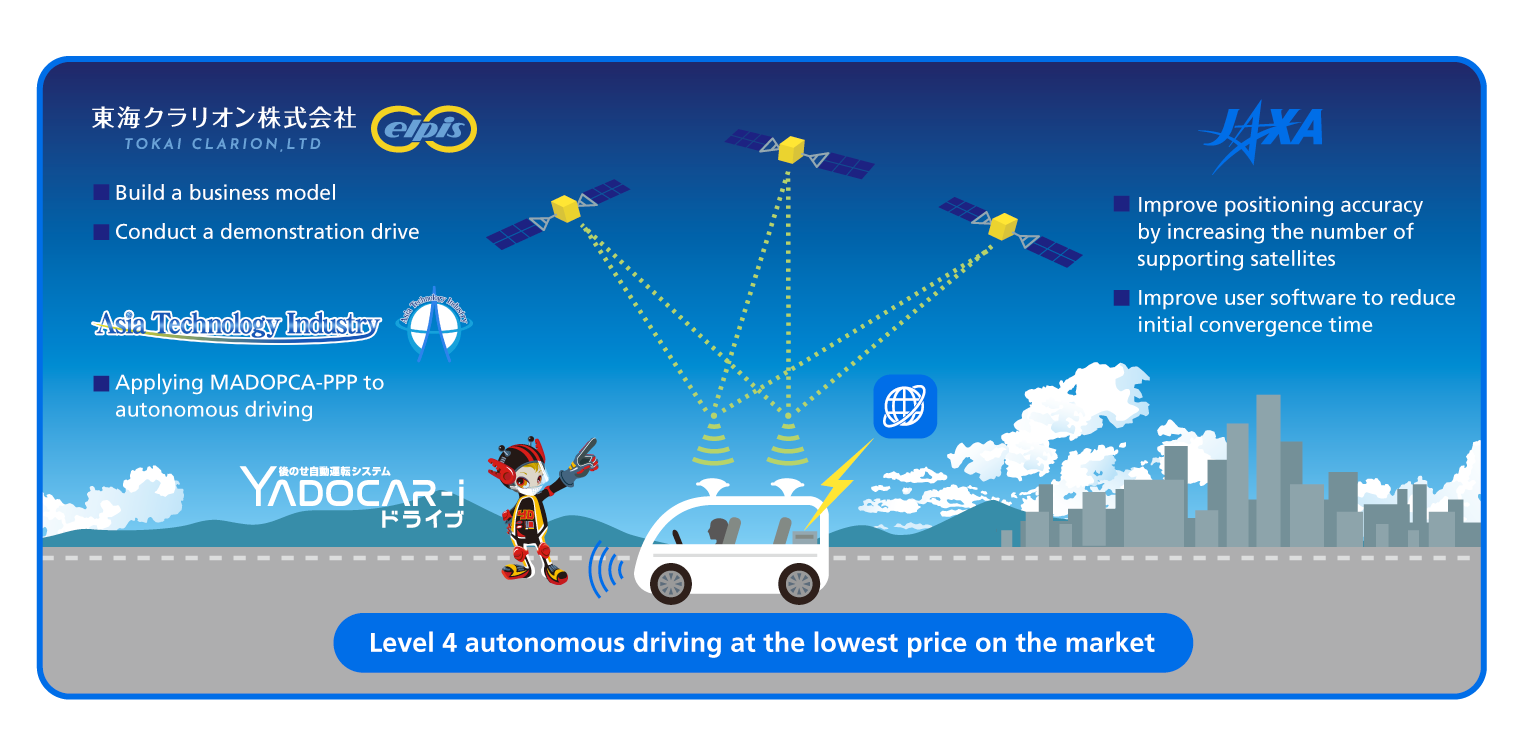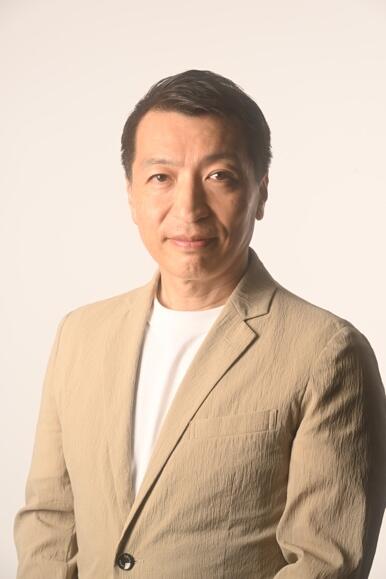JAXA, TOKAI CLARION, LTD., and ATI Start Co-Creation Activities Named “Add-on Autonomous Driving ‘YADOCAR-i Drive’”
〜Level 4 autonomous driving at the lowest price on the market by utilizing satellite positioning technology〜
August 8, 2023 (JST)
Japan Aerospace Exploration Agency (JAXA)
TOKAI CLARION, LTD.
Asia Technology Industry Co., Ltd.
TOKAI CLARION, LTD. (Representative Director: Gentaro Abe, hereinafter referred to as “TCL”) *1, Asia Technology Industry Co., Ltd. (Representative: Akira Nagao, hereinafter referred to as “ATI”)*2, Japan Aerospace Exploration Agency (President: Hiroshi Yamakawa, hereinafter referred to as “JAXA”) have started, under the framework of “JAXA Space Innovation through Partnership and Co-creation (hereinafter referred to as J-SPARC)”*3 that aims to create new ideas for space related-businesses, co-creation activities named “Add-on Autonomous Driving YADOCAR-i Drive”*4 from June2023.
TCL and ATI are developing "YADOCAR-i Drive," which aims to realize Level 4 autonomous driving*5 in limited areas. In this co-creation, Precise Point Positioning “MADOCA-PPP*6," which utilizes JAXA's centimeter-class positioning augmentation signals, will be applied to “YADOCAR-i Drive” to demonstrate improved positioning accuracy and speed. The combination of YADOCAR-i Drive and MADOCA-PPP aims to implement Level 4 autonomous driving as a means of transportation for daily use in depopulated towns and for the “last mile” in tourist destinations (the last section of the journey for people in need of transportation to reach their destination) at the lowest price on the market.

©JAXA/TCL/ATI
[Background of co-creation activities]
In more than 2,000 communities struggling for survival nationwide, autonomous driving cars are expected to provide a means of livelihood for those who are transportation-disadvantaged. For the daily transportation of elderly people in depopulated areas, there is a need for inexpensive autonomous driving vehicles that can travel along fixed routes and narrow roads at low speeds.
In addition, there are many situations in which autonomous driving vehicles are needed, such as the “last mile” at tourist spots and transportation in wineries at domestic and international resorts.
To meet such needs, TCL and ATI are jointly developing YADOCAR-i Drive, which will realize autonomous driving with minimal additional equipment added on existing mobility. To minimize additional equipment and standardize the system for both domestic and international use, YADOCAR-i Drive uses QZSS position information with the Quasi-Zenith Satellite "MICHIBIKI" as the linchpin to create driving routes. Specifically, Precise Point Positioning (MADOCA-PPP) is used. MADOCA-PPP utilizes centimeter-class positioning augmentation signals for demonstration tests transmitted on the L6E channel of MICHIBIKI No. 2, MICHIBIKI No. 4, and the successor to the Quasi-Zenith Satellite-1 "MICHIBIKI.”
The combination of JAXA's advanced high-accuracy positioning technology (MADOCA-PPP) and the field demonstration run of autonomous driving system conducted by TCL/ATI is expected to achieve Level 4 autonomous driving.
[Details of the co-creation activities]
TCL will propose the “Add-on Autonomous Driving System YADOCAR-i Drive” to municipalities and tourism-related industries as a model for utilizing low-cost autonomous driving, conduct autonomous driving demonstrations to visualize the usefulness and convenience of the system.
ATI will collaborate with CORE CORPORATION, which develops and manufactures multi-GNSS receiver compatible with MADOCA-PPP, to develop autonomous driving systems that adapt to different environments at each site. In addition, by feeding back driving results to receiver development, ATI will optimize the receiver to be used for autonomous driving, aiming to advancing the entire autonomous driving system.
JAXA is continuously working on the development of MADOCA and MADOCA-PPP technologies and aims to implement them in society so that satellite positioning users can perform centimeter-class high-accuracy positioning at any time and place in the world. Satellite positioning performance is highly dependent on users’ usage pattern and environment. In this co-creation, we will have MADOCA respond to “MICHIBIKI” L1 and L5 signals and BeiDou3, a Chinese satellite positioning system, in order to improve positioning performance and convenience for users aiming to achieve Level 4 autonomous driving by low-speed EVs. This will increase the number of supporting satellites by more than 30. In urban and mountainous areas with limited sky visibility, the MADOCA-PPP service of the Quasi-Zenith Satellite System will be supplemented with ground-delivered information to improve positioning accuracy. We will also aim to reduce the initial convergence time from 20 minutes previously required to less than one minute by advancing MALIB, a user positioning software that performs Precise Point Positioning by processing calculations using correction information generated by MADOCA.
With collaboration among the three parties, we will create a feedback loop between development and utilization by advancing MADOCA and MADOCA-PPP in parallel with conducting demonstration runs of YADOCAR-iDrive in the first one to two years. We plan to accumulate operational results during that period and accelerate the subsequent application of the results in the field.
[The future we are aiming for]
Providing autonomous driving at a reasonable cost will make Japan a country of smart cities. Until now, it has been difficult to introduce expensive autonomous driving vehicles, despite existing local issues. In this co-creation, we aim to provide autonomous driving at the lowest price on the market by utilizing satellite positioning technology. If we can introduce such autonomous driving to tourist areas where no “last mile” transportation is available, urban areas where people are in need of daily transportation for nursing care and going to hospital regularly, and communities struggling for survival suffering from the risk of accidents involving elderly people, we believe that a combination of various services in terms of convenience and profitability can be created and operating costs can be reduced to as little as possible.
*1 TOKAI CLARION, LTD.
For 75 years since our founding as a sales agent of onboard equipment, we have been listening to the needs of customers right in front of us in the changing automotive industry, combining various products and services, and working with customers to propose necessary solutions. And now that the mobility society is called “Connected Automated/Autonomous Shared & Service Electrification (CASE), TOKAI CLARION, LTD. has evolved into a company that plans and develops products on its own. As a “trading company that also develops products," we are constantly keeping an eye on the changes of the times and listening to our customers who need to solve their issues so that we can be a company that can deliver what customers "want" sooner than any other company. We will continue to create new products and services that combine the technologies required for the mobility of the future, such as autonomous driving, communications, AI, and image processing.
https://www.tokai-clarion.co.jp/(Japanese Only)External link
*2 Asia Technology Industry Co., Ltd.
ATI is a technology venture company based in Thailand. In the automotive research and development area, we are well versed in hardware design and manufacturing, software development, analysis, and evaluation. We provide support from the proposal of optimal system design to development, manufacturing, and supply according to customer requests. We also work to solve technical problems that our customers are currently facing.
https://www.ati.co.thExternal link
*3 JAXA Space Innovation through Partnership and Co-creation (J-SPARC)
J-SPARC (JAXA Space Innovation through Partnership and Co-creation) is a co-creative R&D program that starts through dialogue between JAXA and companies in the private sector that aim for space business. Based on their respective commitments to commercialization, JAXA and the companies will jointly make examinations for a business concept and develop and demonstrate technologies in an exit-oriented manner toward gaining new technologies for the creation of a new business. This co-creative R&D program was launched in May 2018, and so far under the program, about a total of 40 projects and activities were conducted, which also contributed to the launch (commercialization and start of service) of various businesses by companies in the private sector, including those related to food, daily goods, education, VR, entertainment, avatar, communication and small satellite constellations. For the co-creation of a business concept, activities such as market research and concept examination will be conducted, and for the joint demonstration of a new business, activities such as joint feasibility study for commercialization as well as joint technological development and demonstration will be conducted.
https://aerospacebiz.jaxa.jp/solution/j-sparc/(Japanese Only)
*4 YADOCAR-i Drive
YADOCAR-i Drive allows autonomous driving functions to be added on existing vehicles, ranging from a two-passenger micro EV to an eight-passenger microbus.
Video image of "YADOCAR-i Drive" driving
https://youtu.be/H0bWSrzJjgQ(Japanese Only)External link
*5 Automated Driving Level 4
Advanced autonomous driving system performs all dynamic driving tasks, and responds in a limited area in the event of operational difficulty.
Based on the Guideline regarding Safety Technology for Autonomous Driving of the Ministry of Land,
Infrastructure, Transport and Tourismhttps://www.mlit.go.jp/common/001253665.pdf(Japanese Only)![]()
* MADOCA (Multi-GNSS Advanced Demonstration tool for Orbit and Clock Analysis): Software developed by JAXA to achieve the precise multiple GNSS orbit and clock estimation.
MADOCA-PPP: High-accuracy positioning augmentation service to achieve centimeter-class positioning with augmented information generated by MADOCA. The Cabinet Office plans in 2024 to officially launch services delivered from the Quasi-Zenith Satellite System. JAXA complements this plan by developing technology for an Internet distribution service that can be used worldwide.
<Comment from Representative Director Gentaro Abe, TOKAI CLARION, LTD.>
Although TOKAI CLARION, LTD. is a latecomer as a supplier of autonomous driving mobility, we are very honored and grateful to be able to accelerate efforts toward the practical application of simple, yet highly safe autonomous driving through co-creation with JAXA. If we can provide Level 4 autonomous driving to existing vehicles at the lowest price on the market, it will help many municipalities solve problems and improve the quality of life for their citizens. We will spare no effort so that we can be of help to change the social system.

<Comment from Representative Akira Nagao, Asia Technology Industry Co., Ltd.>
In recent years, the number of satellites available for satellite positioning has increased significantly, which has led to significant improvement in positioning accuracy and reliability. This will allow for the maximum use of this satellite positioning in the field of autonomous driving, which will lead to reducing system costs. With this opportunity for co-creation with JAXA, we will work to build a system with the enhanced reliability required for automated driving in the future.

<Comment from Senior Chief Officer of Satellite Navigation Technology Satoshi Kogure, Space Technology Directorate I>
The JAXA Satellite System Technology Unit is engaged in research and development of technologies for precise GNSS orbit and clock estimation and its application and utilization technologies. We are very pleased to have this opportunity to contribute to solving social issues in the world through the technological achievements we have developed. We believe that low cost is an important point for many people to be able to use and experience the joy of using our products. We would like to contribute by developing positioning algorithms that can maintain high performance in a variety of usage environments.

End